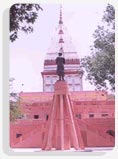
585 kilometers away from
the capital of India (Delhi), situated at the foothills of
Trikuta, besides the river Tawi at an altitude of 1030 ft.
is Jammu, a historical city. Land of brave Dogras known for
their heroic deeds is a land of peace. Dogras are handsome
and artistic people who love beautiful things. Western travelers
in the past ranked the people of Jammu as most gentle, elegant
in the manners, decent, handsome, 'Bhalamanous' (noble and
gentle) polished, gallant, agile, well skilled, cautious,
refined, scholarly, able and moderate.
According to a Legend, King Jambulochan on seeing a tiger
and a goat drinking water from the same pool was struck by
the harmony and peace of this place and founded a City here-Jammu.
It is also said that the history of the City is much more
old and is related to Jamawant, one of the warriors in Rama's
army, who used to practice austere penances here in a cave
near Pir-Khoh.

Jammu has numerous temples in its lap and hence called the
City of Temples. Linked with rail, road and air it has emerged
as a big trading centre in the recent years. The view of the
dawn and dusk of this sacred city is simply enchanting. In
the crowded busy bazars people rub their shoulders to bargain
for Kashmiri dry fruit, Bhadarwahi Rajmash, Kashmiri Shawls,
Phirons, artificial jewellary, wood work etc. All bazars in
the city have their own peculiarities and specializations.
Raghunath Bazar a big retail market, Kanak Mandi a whole sale
market, Pacca Danga for books, Jain Bazar for Jewellary, Linkroad
a ladies shopping hunt etc, are the few bazars of their own
type - in this way it has to offer many things for which a
tourist is at the look out.
